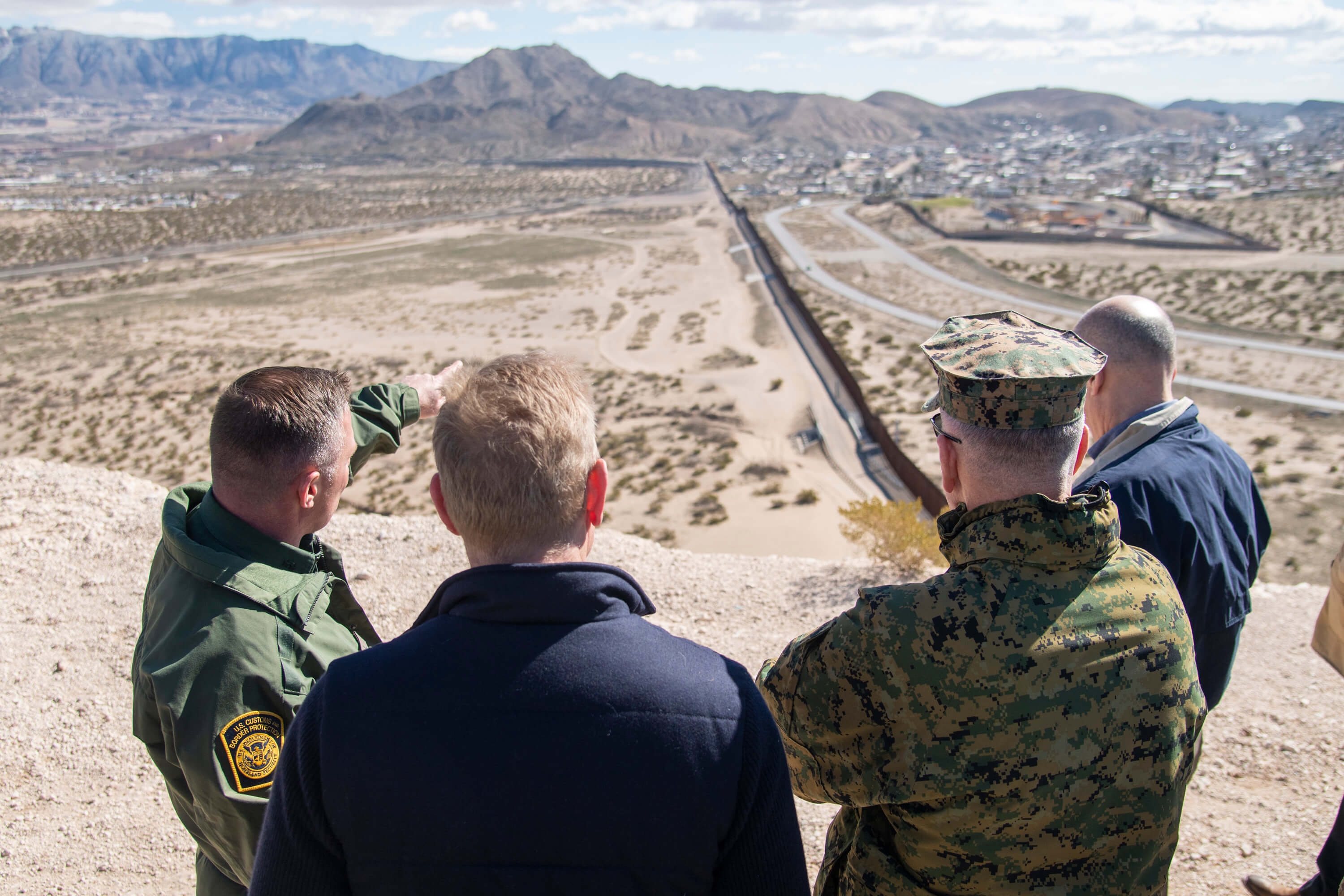Biden’s Resurrection of Emergency Powers at the Southern Border

Published by The Lawfare Institute
in Cooperation With

On May 2, the Department of Defense announced that an additional 1,500 active-duty soldiers and Marines will be sent to the southern border to support the Department of Homeland Security (DHS). There have been reports for some time about Biden’s adoption of Trump-era southern border policies. The same can be said of the striking similarities between how the Trump and Biden administrations use law (both emergency and non-emergency powers) to sustain the continued deployment of thousands of military personnel at the southern border.
Last week the Defense Department announced that Secretary of Defense Lloyd Austin approved a 90-day deployment of 1,500 active-duty personnel in response to a request for assistance from DHS, the usual forcing mechanism for deployments at the southern border. These personnel will provide “ground-based detection and monitoring,” “data entry,” and “warehouse support.” And the public was informed that the Defense Department will try to replace these active-duty forces with reserve component (for example, Army Reserve or Army National Guard) personnel and contracted support. Importantly, these 1,500 personnel won’t be alone. There are already 2,500 military personnel providing “detection and monitoring” and “aviation support” to DHS at the southern border.
On his first day in office, President Biden signed Proclamation 10142, which terminated the national emergency declared by President Trump at the southern border. The proclamation largely criticized the border wall, which in part was built using a construction authority (10 U.S.C. § 2808) that Trump made available through the emergency declaration. But this declaration did more than just pave the way to building a wall. It also made available 10 U.S.C. § 12302. This statute authorizes the secretaries of the military departments, in response to a national emergency, to order any member or unit of any reserve component (including National Guard personnel) to active duty, without their consent, for no longer than two years. It’s likely, though reliable numbers are not readily available, that at least some of the thousands of National Guard personnel sent to the border during the Trump administration were deployed under this authority.
Biden took the first step toward a return to emergency authority on Dec. 15, 2021. In Executive Order 14059, he found that “international drug trafficking ... constitutes an unusual and extraordinary threat to the national security, foreign policy, and economy of the United States.” In response, he ordered the secretary of the treasury to impose specified sanctions and restricted the entry of noncitizens who qualified for such sanctions. On April 27, 2023, in Executive Order 14097, Biden again made the authority provided in § 12302 available to respond to this emergency.
Swapping out emergency authority to build a wall for emergency authority to sanction narcotraffickers, Executive Order 14097 in all but name resuscitates the operational authorities provided by Trump’s executive order. There is certainly a difference in rhetoric and policy focus—Trump’s centered on migration, Biden’s on drug trafficking. But as a legal matter, they both uncorked nearly unrestricted, easy access to military personnel for the southern border.
Statutory Authority for Southern Border Military Deployments
Notwithstanding all the above, there’s actually very little in the way of emergency authority that the Defense Department needs to support DHS at the southern border. The relevant statutes authorizing Defense Department operational support have been on the books for decades. In this regard, the Trump administration was exceptional only in the number of personnel deployed under this legal framework.
While we aren’t told much about the law governing this newest 1,500-person deployment, we can stitch together a pretty detailed picture from publicly available information. I’ll approach it through the three buckets of legal questions relevant to analyzing Defense Department operational support to another federal agency: (a) What’s the operational authority for the activities that military personnel will perform? (b) What’s the mobilization authority under which the personnel will operate? and (c) What appropriation is legally available to fund the operation?
Operational Authority
The statutes discussed below were employed repeatedly to respond to similar requests for assistance in the Trump administration. This isn’t particularly surprising, since they apply generally and don’t require a declaration of national emergency. There’s a lot of statutory law here, so buckle up.
First, and most importantly, are the authorities codified at Chapter 15 of Title 10. Among many other forms of support, these statutes authorize the secretary of defense, at the request of civilian law enforcement agencies (like the secretary of homeland security), to loan Defense Department equipment and to maintain and operate such equipment. For example, “ground-based detection and monitoring” is authorized in § 274(b)(2)(C), which allows Defense Department personnel to “operate equipment for the following purposes: ... (B) Detection, monitoring, and communication of the movement of surface traffic outside of the geographic boundary of the United States and within the United States not to exceed 25 miles of the boundary if the initial detection occurred outside of the boundary.” Section 274(b)(2)(D), which authorizes “aerial reconnaissance,” by all accounts would also authorize the aviation support the Defense Department is already providing to DHS.
Support under § 274 must aid in enforcing specified law enforcement activities. Among them are activities to enforce the Controlled Substances Act and sections of the Immigration and Nationality Act. Biden’s executive order seems to make clear that either could be at play here.
This monitoring and detection support might equally be provided under 10 U.S.C. § 284(b)(6)(B), which authorizes detection, monitoring, and communication of surface traffic on the same terms as § 274, or § 284(b)(10), which more generally authorizes “aerial and ground reconnaissance.” Unlike § 274, support under § 284 must be related to counterdrug or counter-transnational organized crime activities.
There are a few criteria that must be met regardless of which provision of Chapter 15 the Defense Department employs. For example, due to both the Posse Comitatus Act and 10 U.S.C. § 275, military personnel can’t directly participate in law enforcement functions. (This piece is not about the executive branch’s interpretation of the Posse Comitatus Act, but the Justice Department provides a flavor in this recent Department of Justice Office of Legal Counsel opinion.) The Defense Department stipulated that this requirement is currently met. Third, the support can’t “adversely affect the military preparedness of the United States.” Again, the Defense Department stipulated that the support won’t affect military readiness—a seemingly higher threshold, defined by the Defense Department as “the ability of military forces to fight and meet the demands of assigned missions.” And, finally, this support must be provided on a reimbursable basis, subject to a few exceptions (more on this below).
What about “data entry” and “warehouse support”? A few options seem available. For the Defense Department to use § 274, there must be some operation of equipment. That could plausibly include a soldier using a computer. Under this theory, the Defense Department would resort to 10 U.S.C. § 274(c), a catch-all for any support that doesn’t involve direct participation in law enforcement activities. There doesn’t seem to be a plausible way for warehouse support to fit here, unless using a hand truck or forklift constitutes using equipment. A capacious fallback, however, would be § 1059 of the National Defense Authorization Act (NDAA) for fiscal year 2016. It provides, in pertinent part, that the secretary of defense may support Customs and Border Protection “for purposes of increasing ongoing efforts to secure the southern land border of the United States” through, for example, the “deployment of members and units of the regular and reserve components of the Armed Forces to the southern land border of the United States.” That’s an incredibly broad authorization. Whatever is true about the probity of using troops as factotums and warehouse workers, both duties are certainly a deployment to the southern land border.
Mobilization Authority
There’s a truly dizzying array of mobilization authorities, and no shortage of personnel issues, due to the way in which they interact and how they’ve been implemented by the Defense Department and the military departments. Thankfully, at least in the near term, this is likely to be the most straightforward part of the deployment. The Defense Department says that the 1,500 troops will be active-duty forces, meaning they don’t require an additional or separate mobilization for this support mission. But on the theory that, much like Chekov’s gun, a legal authority once made available must be used, I expect the Defense Department to use Biden’s proclamation to mobilize National Guard or other reserve component personnel under § 12302 in the future.
Fiscal Authority
It’s pretty likely that, as during the Trump administration and notwithstanding some factual difficulty, DHS won’t reimburse the Defense Department for the cost of this deployment. Although 10 U.S.C. § 277 requires that law enforcement agencies reimburse the Defense Department for any support provided under Chapter 15, the secretary of defense can waive this requirement if one of two criteria are met: (a) The support “is provided in the normal course of military training or operations” or (b) the support provides the military personnel a benefit “substantially equivalent to that which would otherwise be obtained from military operations or training.” I haven’t found any indication of whether Secretary Austin has exercised this waiver for the current deployment. Factually, it seems like a difficult case to make for at least some of the support functions. The first criterion certainly doesn’t apply to any of them (none of this is part of a steady-state Defense Department mission). And it seems like a stretch, at best, to say that young troops need training in how to use a computer or move supplies in a warehouse. But these are factual judgment calls, and senior Defense Department officials have readily asserted a training value for similar duties in the past.
If some support is provided under 10 U.S.C. § 284, Defense Department funds would be used. Unlike other support provided under Chapter 15, the Defense Department receives an annual appropriation for counternarcotics support to law enforcement agencies. In Title VI of the Department of Defense Appropriations Act for 2023, for example, upward of $614 million is provided for such support. Which leaves us with support under § 1059. Although reimbursement was limited to a maximum of $75 million when the NDAA was enacted in 2016, Congress has imposed no further limits or authority to receive reimbursement (including when the statute was amended in 2021).
***
It’s entirely correct, as DHS notes, that the Department of Defense has for the vast majority of the past two decades provided support at the southern border. But easy access to any component of the Defense Department appears to be turning into a new normal, made available under shifting but substantially similar emergency declarations. Thousands of military personnel are consistently deployed to the border. And all of it is funded by the Defense Department. All of which is to say that, in an increasingly substantial way from which it may be increasingly difficult to retreat, U.S. border security has become a Defense Department mission.





